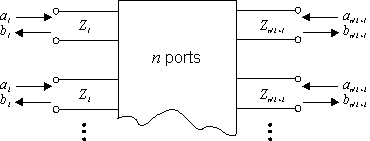

Considering an element with n ports, we obtain for the incoming wave, ai, and the outcoming wave, bi, at port No. i:

with the voltage, Vi, the current, Ii, and the reference impedance, Zi.

Describing the relationship between an outcoming and an incoming wave by an S-parameter and writing these parameters in matrix form leads to the S-matrix:

In general, considering frequency domain, this gives frequency-dependent S-Parameters: Sij = Sij(f).
Note that a main diagonal element describes the reflection at the related port; the other elements are transmission factors between two ports. If the element contains only reciprocal materials and if all reference impedances are real the S-matrix is symmetric: Sij = Sji.
In practice, the S-matrix is highly relevant because of the following two aspects:
The relation between incoming and outcoming waves and voltages and currents given above is valid for real-valued reference impedances Zi. The extension to complex-valued reference impedances is not unique. The two most commonly used wave definitions with complex-valued reference impedances are the power waves
(where * denotes complex conjugate), and the pseudo waves
CST DESIGN STUDIO™ calculates S-Parameters based on power waves. S-Parameters based on pseudo waves may be obtained via the Calculate Pseudo Wave S matrices context menu item of any S-Parameter tree folder with complex-valued reference impedances. Both wave definitions reduce to the same definition for real-valued reference impedances.
It is worth noting that not all known properties of S-parameters with real-valued reference impedances Zi are still valid if complex-valued reference impedances Zi are used.
Power waves and S-Parameters based on power waves have the following properties:
 .
. .
. .
.Pseudo waves and S-Parameters based on pseudo waves have the following properties:
 .
. .
. .
.Further references are K. Kurokawa, "Power Waves and the Scattering Matrix", IEEE Transactions on Microwave Theory and Techniques, vol. MTT-13, pp. 194-204, 1965 (power waves) and R.B. Marks and D.F. Williams, "A General Waveguide Circuit Theory", J. Research of the National Institute of Standards and Technology, vol. 97, pp. 533-561, 1992 (pseudo waves).
See also